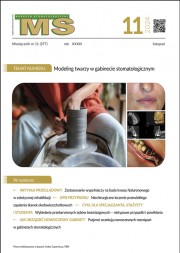Dostęp do tego artykułu jest płatny.
Zapraszamy do zakupu!
Po dokonaniu zakupu artykuł w postaci pliku PDF prześlemy bezpośrednio pod twój adres e-mail.
Celem pracy było porównanie szczelności materiałów MTA Angelus Grey (Angelus, Brazylia), Tech Biosealer Apex (Isasan, Włochy) oraz Biodentine (Septodont, Francja) w zębach z niezakończonym rozwojem wierzchołka. Do badania użyto 66 usuniętych zębów ludzkich. Na podstawie zdjęć rentgenowskich sklasyfikowano stopień rozwoju korzeni, a następnie dokonano podziału zębów na trzy równe pod względem jakościowym grupy badane – po dwadzieścia zębów każda oraz dwie grupy kontrolne – pozytywną i negatywną (po trzy zęby). Po odcięciu koron zębów kanały korzeniowe opracowano chemo-mechanicznie do rozmiaru 80-120 wg ISO. Po obfitym płukaniu i wysuszeniu kanały korzeniowe wypełniono badanymi materiałami w zależności od grupy: grupa 1 – MTA Angelus Grey, grupa 2 – Tech Biosealer Apex, grupa 3 – Biodentine. Korzenie z wypełnionymi kanałami umieszczono na jedną dobę w świeżym kawałku zwierzęcej tkanki mięśniowej, a następnie zanurzono na 6 dni w DPBS. Po okresie inkubacji, korzenie pomalowano lakierem szybkoschnącym, a następnie poddano tygodniowej kąpieli w tuszu kreślarskim typu „India Ink”. Po wyjęciu z barwnika, opłukaniu, nacięciu wzdłuż i rozłupaniu korzeni, dokonano pomiaru głębokości przecieku. Dane poddano analizie statystycznej testami U Manna-Whitney’a oraz t-Studenta. Największa szczelność cechowała wypełnienia z materiału MTA Angelus Grey. Nie stwierdzono istotnych statystycznie różnic między materiałami Biodentine i Tech Biosealer Apex.
The aim of the study was to compare the sealing ability of the materials MTA Angelus Grey (Angelus, Brazil), Tech Biosealer Apex (Isasan, Italy) and Biodentine (Septodont, France) in teeth with incomplete development of the apex. Sixty six extracted human teeth were used for the study. The level of root development was classified on the basis of radiographs and this was followed by division of the teeth into three studied groups, that were even as to quality – with twenty teeth in each group and two control groups – one positive and one negative (three teeth in each). After removal of the tooth crowns the root canals were instrumented chemically and mechanically to size 80-120 ISO. After thorough rinsing and drying the root canals were filled with the materials under study according to the following groups: group 1 – MTA Angelus Grey, group 2 – Tech Biosealer Apex, group 3 – Biodentine. The roots with filled canals were placed in a fresh piece of animal muscle tissue for 24 hours, and then immersed for 6 days in DPBS. After a period of incubation, the roots were painted with quick-drying varnish and then they were subjected to a week’s bath in draftsman’s “India Ink”. After removal from the dye, rinsing and longitudinal sectioning, measurement was made of the depth of penetration of leakage. The results were subjected to statistical analysis using the U Mann-Whitney test and Student t-test. The greatest sealing ability was found in fillings using the MTA Angelus Grey material. There were not found to be any statistically significant differences between the materials Biodentine and Tech Biosealer Apex.













